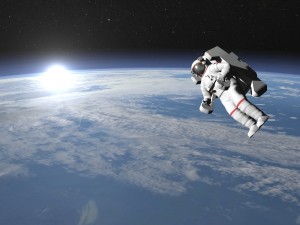 Earlier this year, NASA celebrated its 60th anniversary as a federal government agency. I’ve seen numerous news articles and events highlighting milestones, biographies, and research. One of the more interesting developments is NASA’s Home and City interactive website update.
Earlier this year, NASA celebrated its 60th anniversary as a federal government agency. I’ve seen numerous news articles and events highlighting milestones, biographies, and research. One of the more interesting developments is NASA’s Home and City interactive website update.
What some people may not realize is that much of the research and development done by NASA has broader applications than space (I’m not just talking about the pens that write upside down) and have been used in many everyday commercial products. NASA’s Home and City page highlights 130 inventions that are used in everyday life that were based on NASA technology.
For example, if you’ve ever watched a football game on TV, you’ve likely seen an aerial shot of the stadium. These stadium roofs are often made with “NASA technology developed for use in Apollo spacesuits. Structures made from this moisture-resistant fiberglass material—stronger than steel but weighing only five ounces per square foot—are energy efficient, immune to pollutants and ultraviolet rays, and are translucent enough for natural-grass playing fields.” Skiers will be familiar with the blue-light cancellation technology in ski goggles. A water filtration bottle, insulating foam, and enriched baby food are a few more examples of innovations that relied on NASA’s inventions. Additional examples can be found in NASA’s annual Spinoff publication, which highlights the commercialization of NASA’s patents dating back to 1976.

The Trump Gold Card: A New $1 Million Pathway To A U.S. Green Card
A new proposal would let wealthy foreign nationals secure an opportunity for a U.S. green card with a $1 million 'gift' to the government, sparking legal and ethical debate.
Unlike copyright, in which works created by the federal government are in the public domain in the United States and free to use, the government can and does own numerous patents. NASA has a substantial patent portfolio. However, unlike many private companies, NASA’s patent strategy is focused on promoting development and access, rather than a defensive patent strategy to prevent others from relying on the technology. A presentation by Dan Lockney, Technology Transfer Program Executive at NASA, earlier this year noted several criteria for patent applications by the agency, including only patenting technology that can be brought to market within seven years and that which a patent license is deemed the best way to get the technology to the market. Additionally, some of NASA’s patents may actually have a defensive strategy even where a patent license is unnecessary to promote commercialization. NASA can and does dedicate some of its patents to the public domain, which are free to use and innovate on without the need to seek permission. By patenting an invention first, NASA precludes other inventors from obtaining that patent, thereby also preventing the patent being used to exclude others.
Interestingly, NASA offers both exclusive and non-exclusive licenses (as well as “partially excusive within a particular field of use or geographic area”). Although NASA’s intent in licensing its patents is to make products widely available, exclusive licenses may be used where, for example, the lack of exclusivity would fail to bring a product to market. Exclusive or partially exclusive licenses, undergo an extra step in the licensing process; NASA must put a notice in the Federal Register and allow written objections, which can be taken into consideration in the decision to grant or deny a license.
NASA also offers a special “commercial startup NASA license” for United States-based companies, which requires no upfront costs for the use of the license, allowing new products to come to the market without the investment of patent license fees. The startup is required to commercialize the product within three years and, after beginning sales, owes NASA a royalty fee of 4.2 percent, with annual minimum fees of $3,000. According to the NASA fact sheet, “The Startup NASA license offers a specially targeted way to get new technology into the hnads of commercial innovators, achieving our mission of leveraging the capabilities of NASA inventions to benefit high-potential businesses and American taxpayers alike.”
For those interested in finding NASA patents available for license, the agency’s tech transfer page categorizes them into the following areas: aeronautics, communications, electrical, environment, health/medicine, IT/software, instrumentation, manufacturing, materials and coating, mechanical and fluid systems, optics, power generation and storage, propulsion, robotics, and sensors.

Chrometa: Turning Time Into Billable Value For Modern Lawyers
Adoption of Chrometa represents more than a technological upgrade; it reflects a professional philosophy that values accuracy, transparency, and efficiency.
Krista L. Cox is a policy attorney who has spent her career working for non-profit organizations and associations. She has expertise in copyright, patent, and intellectual property enforcement law, as well as international trade. She currently works for a non-profit member association advocating for balanced copyright. You can reach her at [email protected].